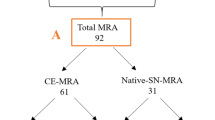Abstract
Purpose
The purpose of this study was to compare two non-contrast 2D techniques with the current contrast-enhanced MRI standard 3D technique for the routine assessment of thoracic aortic pathologies.
Methods
One hundred patients with suspected or known thoracic aortic diseases were examined with a 1.5 T scanner using 2D turbo spin echo (TSE), 2D balanced steady state free precession (balanced SSFP) and 3D contrast-enhanced MR angiography (CE-MRA). The diameters of the aorta at predefined levels were measured. The feasibility to visualize the aortic root and supra-aortic branches was tested. All morphologic abnormalities of the aorta, the aortic wall and the aortic valve, as well as image quality of TSE and balanced SSFP influencing the diagnosis were analysed.
Results
Compared to CE-MRA, balanced SSFP and TSE allowed for the detection of a significantly higher number of relevant pathologies (thickened aortic wall and signs of emergency) in less time. No significant differences were found among the sequences for the identification of aneurysms, dissection membranes and thrombi. No single technique was able to address all clinically relevant issues. TSE was associated with a better image quality compared to balanced SSFP, which however did not translate into a significantly improved diagnostic accuracy.
Conclusion
The total number of pathologic findings was higher using 2D TSE and balanced SSFP when compared to 3D CE-MRA. None of the techniques applied could address all clinically relevant issues. The major drawback of TSE is its relatively long scanning time while balanced SSFP is associated with more artifacts.






Similar content being viewed by others
References
Fattori R., Nienaber CA (1999) MRI of acute and chronic aortic pathology: pre-operative and postoperative evaluation. J Magn Reson Imaging 10(5):741–750
Roberts DA (2001) Magnetic resonance imaging of thoracic aortic aneurysm and dissection. Semin Roentgenol 36(4):295–308
Carr JC, Simonetti O, Bundy J, Li D, Pereles S, Finn JP (2001) Cine MR angiography of the heart with segmented true fast imaging with steady-state precession. Radiology 219(3):828–834
Erbel R, Alfonso F, Boileau C, Dirsch O, Eber B, Haverich A et al (2001) Diagnosis and management of aortic dissection: task force on aortic dissection, European society of cardiology. Eur Heart J 22(18):1642–1681
Ganaha F, Miller DC, Sugimoto K, Do YS, Minamiguchi H, Saito H et al (2002) Prognosis of aortic intramural hematoma with and without penetrating atherosclerotic ulcer: a clinical and radiological analysis. Circulation 106(3):342–348
Chalard F, Ferey S, Teinturier C, Kalifa G (2004) Aortic dilatation in Turner syndrome: the role of MRI in early recognition. Pediatr Radiol 29:29
Kawamoto S, Bluemke DA, Traill TA, Zerhouni EA, (1997) Thoracoabdominal aorta in Marfan syndrome: MR imaging findings of progression of vasculopathy after surgical repair. Radiology 203(3):727–732
Cigarroa JE, Isselbacher EM, DeSanctis RW, Eagle KA (1993) Diagnostic imaging in the evaluation of suspected aortic dissection. Old standards and new directions. N Engl J Med 328(1):35–43
White RD, Obuchowski NA, VanDyke CW, Tkach JA, Geisinger MA, Link KM et al (1994) Thoracic aortic disease: evaluation using a single MRA volume series. J Comput Assist Tomogr 18(6):843–854
Hartnell GG, Finn JP, Zenni M, Cohen MC, Dupuy DE, Wheeler HG et al (1994) MR imaging of the thoracic aorta: comparison of spin-echo, angiographic, and breath-hold techniques. Radiology 191(3):697–704
Carr JC, Finn JP (2003) MR imaging of the thoracic aorta. Magn Reson Imaging Clin N Am 11(1):135–148
Celik T, Iyisoy A, Kursaklioglu H, Unlu M, Kose S, Ozmen N et al (2006) A large calcified saccular aneurysm in a patient with aortic coarctation. Int J Cardiovasc Imaging 22(1):93–95, Epub 2005 Dec 13
Cesare ED, Giordano AV, Cerone G, De Remigis F, Deusanio G, Masciocchi C (2000) Comparative evaluation of TEE, conventional MRI and contrast-enhanced 3D breath-hold MRA in the post-operative follow-up of dissecting aneurysms. Int J Card Imaging 16(3):135–147
Kunz RP, Oberholzer K, Kuroczynski W, Horstick G, Krummenauer F, Thelen M et al (2004) Assessment of chronic aortic dissection: contribution of different ECG-gated breath-hold MRI techniques. AJR Am J Roentgenol 182(5):1319–1326
Didier D, Saint-Martin C, Lapierre C, Trindade PT, Lahlaidi N, Vallee JP et al (2006) Coarctation of the aorta: pre and postoperative evaluation with MRI and MR angiography; correlation with echocardiography and surgery. Int J Cardiovasc Imaging 22(3–4):457–475, Epub 2005 Nov 3
Krinsky G, Rofsky N, DeCorato D, Weinreb J, Earls J, Flyer M et al (1997) Thoracic aorta: comparison of gadolinium-enhanced three-dimensional MR angiography with conventional MR imaging. Radiology 202(1):183–193
Vilacosta I, San Roman JA, Ferreiros J, Aragoncillo P, Mendez R, Castillo JA et al (1997) Natural history and serial morphology of aortic intramural hematoma: a novel variant of aortic dissection. Am Heart J 134(3):495–507
von Kodolitsch Y, Csosz SK, Koschyk DH, Schalwat I, Loose R, Karck M et al (2003) Intramural hematoma of the aorta: predictors of progression to dissection and rupture. Circulation 107(8):1158–1163
Stemerman DH, Krinsky GA, Lee VS, Johnson G, Yang BM, Rofsky NM (1999) Thoracic aorta: rapid black-blood MR imaging with half-Fourier rapid acquisition with relaxation enhancement with or without electrocardiographic triggering. Radiology 213(1):185–191
Urata J, Miyazaki M, Wada H, Nakaura T, Yamashita Y, Takahashi M (2001) Clinical evaluation of aortic diseases using nonenhanced MRA with ECG-triggered 3D half-Fourier FSE. J Magn Reson Imaging 14(2):113–119
Pereles FS, McCarthy RM, Baskaran V, Carr JC, Kapoor V, Krupinski EA et al (2002) Thoracic aortic dissection and aneurysm: evaluation with nonenhanced true FISP MR angiography in less than 4 minutes. Radiology 223(1):270–274
Solomon SL, Brown JJ, Glazer HS, Mirowitz SA, Lee JK (1990) Thoracic aortic dissection: pitfalls and artifacts in MR imaging. Radiology 177(1):223–228
Author information
Authors and Affiliations
Corresponding author
Additional information
R. Gebker and O. Gomaa contributed equally to this paper.
Rights and permissions
About this article
Cite this article
Gebker, R., Gomaa, O., Schnackenburg, B. et al. Comparison of different MRI techniques for the assessment of thoracic aortic pathology: 3D contrast enhanced MR angiography, turbo spin echo and balanced steady state free precession. Int J Cardiovasc Imaging 23, 747–756 (2007). https://doi.org/10.1007/s10554-006-9204-6
Received:
Accepted:
Published:
Issue Date:
DOI: https://doi.org/10.1007/s10554-006-9204-6




